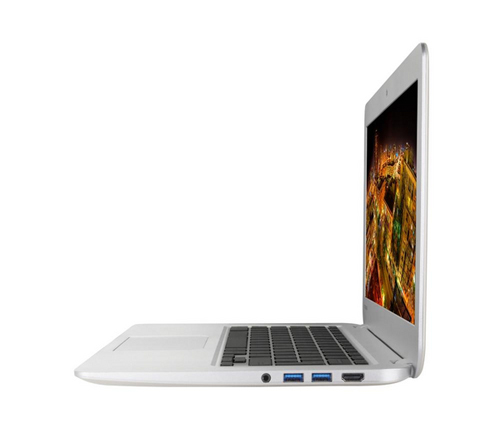This makes them excellent second computers, ones that you can hand to your children or take to places where a £1000 ultrabook might be too tempting a target for thieves. A stunt laptop if you will. This mindset is bolstered by the small form factors that most models adopt, often sporting an 11.6in screen and tablet-level internal components. Toshiba’s first foray into Chromebook territory sees it opt for a more capacious 13.3in display and an Intel Haswell CPU – albeit one of the cheaper Celeron variants. This should give the unit a speed bump over its diminutive siblings and increase the battery life, while opening up possibilities for users who want more real estate on their screens. One thing that the Toshiba Chromebook has in common with those that have come before is that it’s made of plastic. No precision drilled aluminum here, but that’s not a bad thing. The plastic shell is smart, featuring a dappled outer design, and has many elements of styling borrowed from the Apple MacBook Air. Ports are respectable, with two USB 3.0, HDMI, and SD card slots giving you ample ways to increase the 16 GB of internal flash storage. To help take care of your storage limitations, Google also includes 100 GB of Google Drive storage for two years, after which you’ll pay $59.88 plus VAT per year. Lifting the lid reveals a clean, uncluttered layout. Silver, frosted plastic is the order of the day, spoiled only by a couple of Windows-style advertising stickers that seem strangely out of place. A 720p webcam adorns the upper edge of the lid, while the only other aberration is a subtle Toshiba legend in the lower, left corner. The large trackpad is responsive, executes two-finger multi-touch gestures efficiently, and is generally good to use. Keyboard response feels a little shallow initially, but once you use it for a while it’s as easy to type on as the Samsung and HP Chromebooks. Some of the keys traditionally found on normal laptops are missing. For instance there’s no caps lock – which some might argue is an essential item for commenting on internet forums, but of course they’d argue about anything. In it’s place is a Google search key. Hitting this opens a search box through which you can google something online. It’s a small change, but once you get the hang of it being there it’s incredibly useful. The top row of keys also have dedicated online functions, such as Back and Forward buttons for navigating web pages, and the ever-useful Reload button. Of course all of these functions are available on any browser, but the shortcuts make traversing the internet just that little bit smarter and negate the need in many cases for a touchscreen. See also: Group test: what’s the best budget laptop? The LCD screen itself is perfectly usable, with a resolution of 1366 x 768, but it’s lacking in detail when compared to the beautiful IPS display on the HP 11 Chromebook. It can also be too reflective, but this issue is common with low-cost glossy screens, and for the most part it’s good enough for writing, browsing, and watching HD video. See: What’s the best laptop you can buy The machine feels responsive, helped in no small measure by the 1.4 GHz Celeron processor and 2 GB of memory, with less pauses and checkboarding when opening image-heavy sites than on some other models. Battery life is uncertain at present, as our sample expired when it dropped to just 40 percent remaining. When we reran the test, we recorded a time of seven hours, 25 minutes. There are important considerations to bear in mind when using a Chromebook. The first is that to get the best out of them you need to live in the Google universe. Setting up a Chromebook requires a Google account, and all of its features – Googlemail, Google Docs, Google Calendar, the Google Chrome browser – are ones provided by the advertising giant. Apps are only available from the Chrome Store (which continues to grow at an encouraging rate), and you are expected to do most of your activities online, where Google will inevitably track your activities. There are also key apps that you cannot use, such as Office, iTunes, Skype and anything from Adobe. Alternatives exist though in the form of Google Play Music and Hangouts, which work well and can also be accessed by your iOS/Android device. You can even sync your iTunes library to Google Play Music, so your music collection is available from other devices, although this isn’t the same as actually syncing your iPhone with iTunes. Some myths continue to be pushed – we’re looking at you Microsoft – regarding how functional a Chromebook is when offline. Google Docs can create and edit documents without an internet connection, then sync them up once you find a Wi-Fi connection. Apps like Pocket, Wunderlist, and Gmail can all be used whether you’re connected or not. Obviously it’s much better to be on a fast online connection, but that’s becoming true of most other computers.
